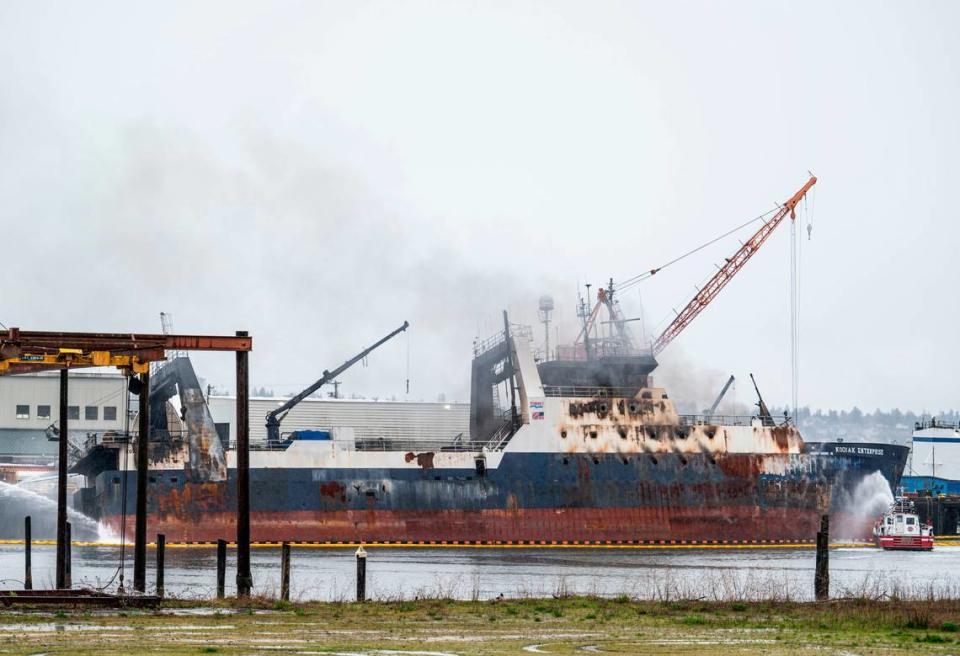Fishing vessel fire in Port of Tacoma still burning 2 days in. Here’s what we know
Smoke continued to rise Monday from a large fishing vessel moored in Hylebos Waterway at the Port of Tacoma. The ship has been burning for more than two days, but fire officials say the worst has passed.
Several schools in Tacoma Public School District started late due to shelter-in-place orders that went into effect Sunday for the neighborhoods of Northeast Tacoma, Browns Point and Dash Point. The Coast Guard announced Monday morning that those orders were lifted because smoke conditions improved. Hylebos Waterway remained closed near the fire.
The smoke will likely be visible throughout the day, but Tacoma Fire Department officials said they’re optimistic that most flammable material onboard the Kodiak Enterprise has burned out. Spokesperson Joe Meinecke said air quality is being monitored, and shelter-in-place orders could be reinstated if conditions worsen.
“It literally will be waiting for it to burn itself out,” Meinecke said.
What is burning?
Early Saturday morning, a fire broke out on the ship, a 59-meter American fishing vessel docked at Trident Seafoods. Several fire agencies have helped respond alongside the Coast Guard, the Environmental Protection Agency and the Washington Department of Ecology.
Firefighters worked aboard the ship throughout most of the day until the heat became too much that night, fire officials previously said. Since then, fire boats and dockside hoses have been pouring water on the hull of the vessel to contain the blaze while it burns.

The fire progressed throughout the ship, and on Sunday, the Coast Guard said the fire was nearing the vessel’s Freon tanks. Freon is a non-combustible gas typically used as a refrigerant in air conditioners. The ship was reportedly holding 19,000 pounds of it in tanks designed to release the gas when it gets too hot. The Coast Guard said Freon can be toxic when inhaled in large quantities, but the release of Freon into the atmosphere wasn’t expected to pose health risks for the public.
Meinecke said Monday it’s presumed that the fire reached the Freon and that the gas was released, but it’s not yet possible to board the ship to confirm that. One minor explosion occurred Sunday evening. He said no one has been injured working the fire.
It’s not yet known how the fire started. Meinecke said investigators will determine that once it burns out.
Are there environmental concerns?
The Coast Guard and the Department of Ecology said Sunday that there have been no signs of pollution in the water. The vessel was estimated to have 55,000 gallons of diesel aboard, and no spills have been reported. Floating barriers called booms were placed around the vessel as a precaution.
Freon also poses some environmental concerns. In 2020, the Environmental Protection Agency banned it from being manufactured in the United States or imported here. Susan Woodward, a spokesperson for the Department of Ecology’s air quality program, told The News Tribune that Freon is a commercial name for the refrigerant R-22, a compound known as a hydrochlorofluorocarbon, something that contains carbon, hydrogen, chlorine and fluorine.
Woodward said Freon traps heat in the atmosphere and also harms Earth’s ozone layer, which protects the planet from harmful radiation from the sun. She said people are still allowed to use existing stockpiles of Freon, and it’s not known how much of the substance still exists.
Freon has a high global warming potential, according to the EPA. Woodward said one pound of Freon emissions is equal to 1,810 pounds of carbon dioxide emissions.
Editor’s note: A previous version of this story incorrectly reported the length of the shipping vessel.

